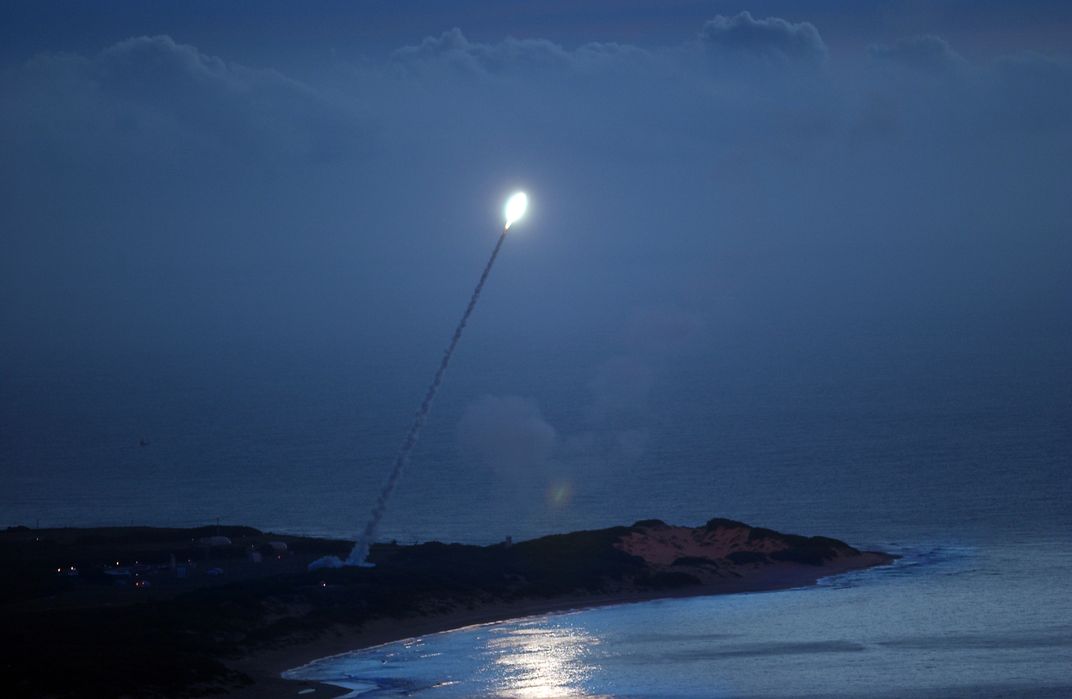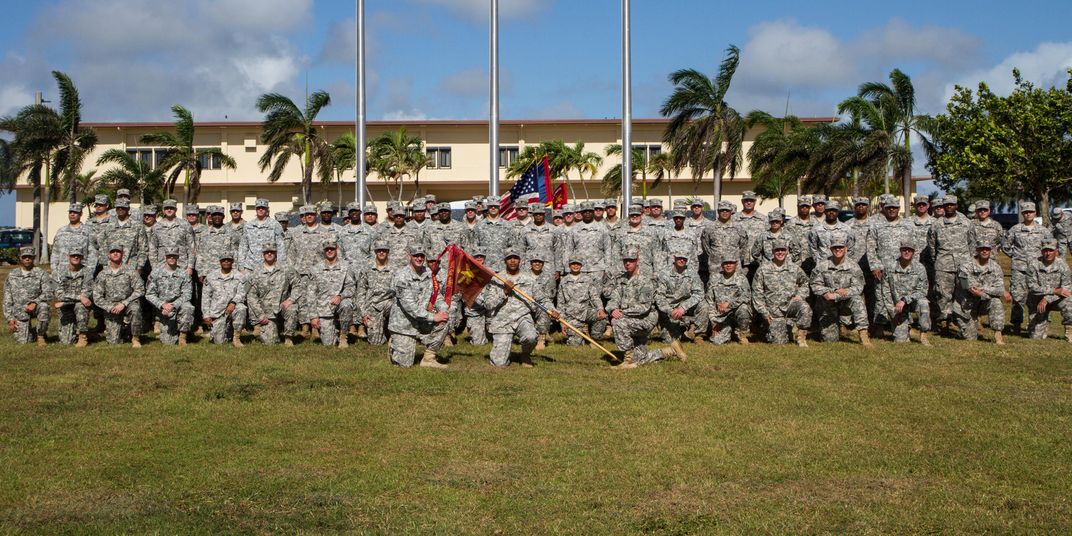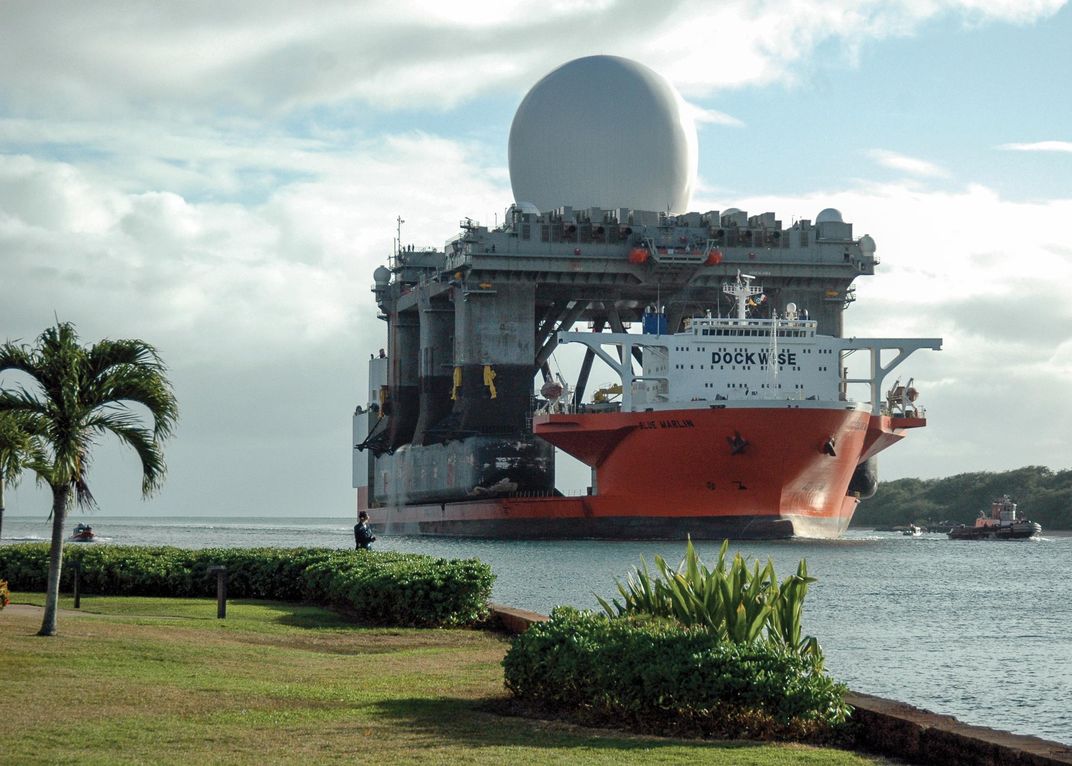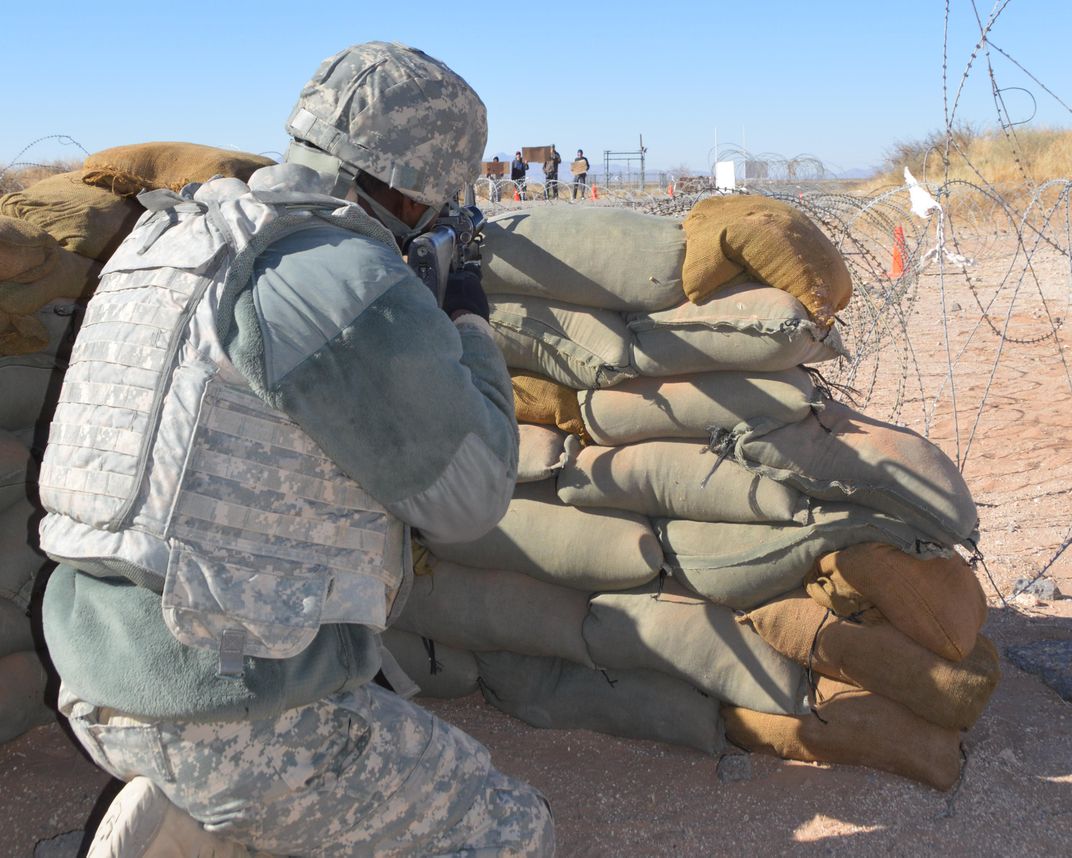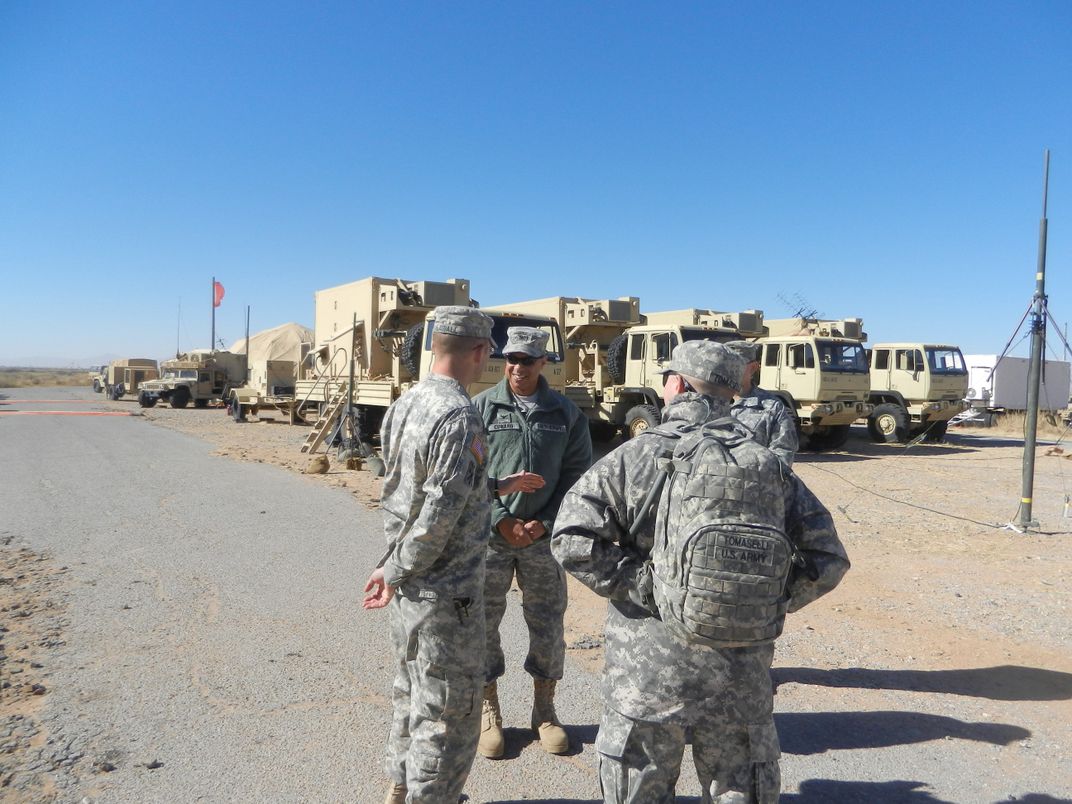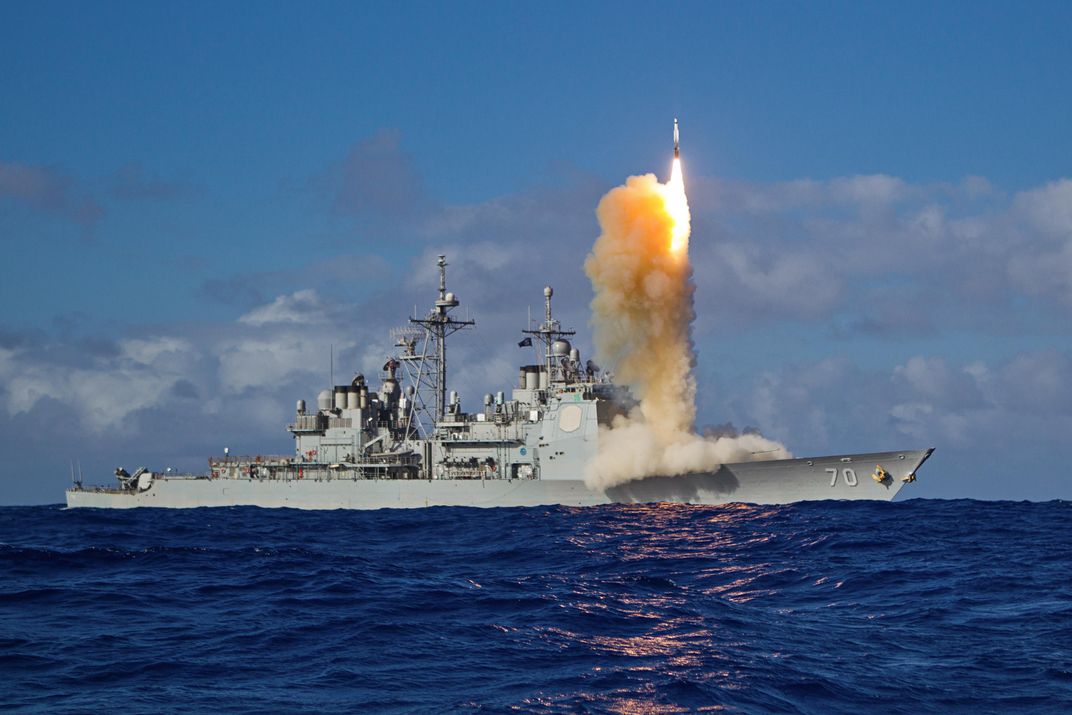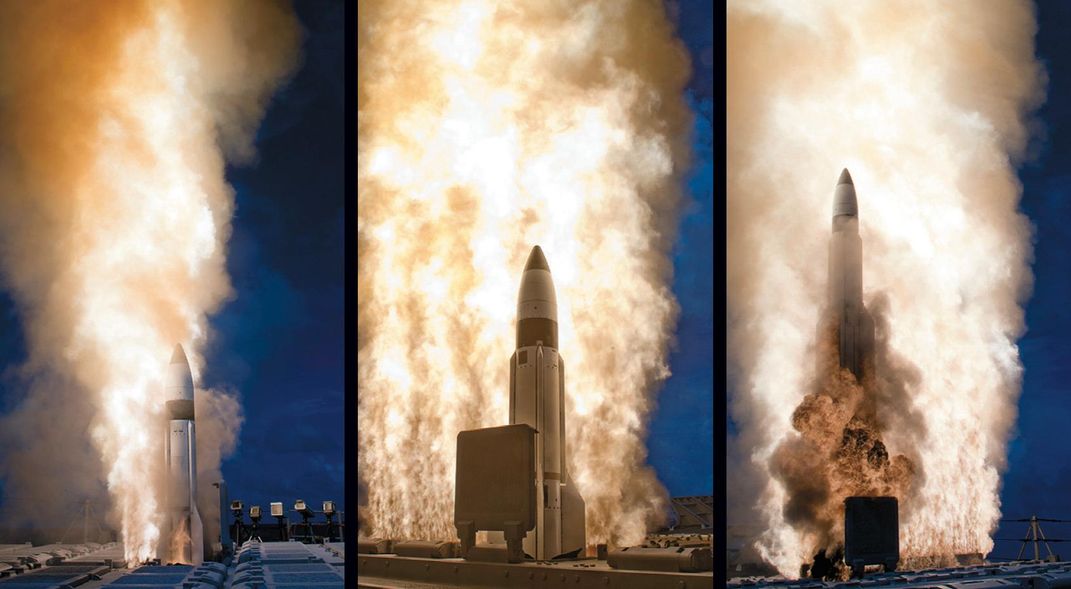How to Stop a Nuke
The Army’s 11th Air Defense Artillery Brigade does a dress rehearsal of a nuclear attack.
:focal(967x346:968x347)/https://tf-cmsv2-smithsonianmag-media.s3.amazonaws.com/filer/c0/ff/c0ff4650-8492-4c3f-9abe-0dba4f493a72/30g_sep2015_intercepttestfto-01_th_1_live.jpg)
The signature of a warhead approaching from space lights up the radar screen. A second appears, then a third. Soldiers of the 11th Air Defense Artillery Brigade are watching, poised at radar, communications, and launch consoles in this dark room. Someday, how these soldiers perform may make the difference between peace and nuclear war. But not today. This is just practice.
The radar blips, the plots of missile trajectories, and the tracks of anti-ballistic missiles screaming toward an intercept on the edge of space are computer simulations, made uncannily realistic by the millions of dollars of launch and radar equipment surrounding these control vans in the New Mexico desert. Razor wire, drawn weapons, and chemical suits add a “This is not a drill” atmosphere to what is, in fact, a drill. They were all part of a mission rehearsal I witnessed in early 2014 at the McGregor Range, a 600,000-acre training area 30 minutes from El Paso, Texas, managed by the Army and the U.S. Bureau of Land Management. On either side of the gate to the range stand Nike, Hawk, and Falcon missiles, interceptors made obsolete by the ones the artillery unit was practicing to fire.
The soldiers of the Alpha-2 anti-missile battery did not know at the time that they were soon to be deployed to Guam, an island of about 200 square miles in the Pacific Ocean and within reach of North Korea’s intermediate-range missiles. In the spring of 2013, North Korea had threatened to strike U.S. bases in Japan as well as Guam’s Andersen Air Force Base, home of the B-52 bombers that had just participated in military exercises with South Korea. Since that time, the Army has deployed anti-missile batteries to Guam in one-year rotations, and next year will station a battery there permanently.
The weapon that Alpha-2 is trained to use is called Terminal High Altitude Area Defense, an anti-ballistic missile system designed to intercept and destroy missiles already headed toward a U.S. target or an ally. Under an Army contract, Lockheed Martin started developing THAAD in the early 1990s, but the first THAAD battery wasn’t fielded at Fort Bliss, Texas, where the 11th Air Defense Artillery Brigade is based, until 2008. The system’s solid-propellant missiles, fired from a mobile launcher, race to the edge of the atmosphere to smash an adversary’s missiles plunging at hypersonic speeds in the final phase of their trajectories toward earth. The first two THAAD batteries at Fort Bliss were equipped with a total of six launchers. Each launcher has eight interceptors.
Not one has yet been fired in combat. But according to the U.S. Missile Defense Agency, flight tests since 2006 have scored 13 intercepts out of 13 tries. From those tests have come data for fine-tuning the simulated battles, like the one Alpha-2 fought in the New Mexico desert. Over the nine-day exercise, Alpha-2 fought up to three mock battles per day.
“They can start like hell on wheels, with a lot of trajectories coming your way,” said First Lieutenant Abraham Acosta, tactical control officer and launcher platoon leader. Or they can be drawn out, as if the enemy fires a couple missiles, then waits…then fires a couple more. “Like they are reloading,” Acosta said.
Alpha-2’s fire control teams, each composed of three soldiers, fought in shifts from vans mounted on the backs of heavy trucks and hardened against chemical and armed assault.
The trucks supporting the control vans were parked side by side a quarter-mile or so from truck-borne launchers. Communications cables connected one to the other, as well as to satellite and ground antennas that link to off-site command centers.
In one control van, Acosta and Sergeant Brent Chapman, the tactical control assistant, sitting next to each other, scoured feeds from ground-, sea-, and space-based sensors. Alone in a second van, Specialist Christopher Steil, the launch control system operator, checked the status of launch control and communications equipment and listened for orders from Acosta. Headsets on, microphones curled to their lips, these three members of the fire control team read LCD display screens that showed the location of incoming warheads and the status of interceptors and communications links.
Fifty yards away, in a domed tent that served as camp headquarters, Captain Pete Lawall and his staff read the same data and heard the same communications the fire control team got. If these were live-fire situations, Lawall and his team would be talking to commanders throughout the Command and Control, Battle Management, and Communications structure that integrates the several layers of the U.S. Ballistic Missile Defense Network. The order to fire a THAAD missile comes from Acosta, the tactical control officer, in the next van over. But the order has to be authorized through the command network: officers who would be on the line with Lawall. The fire control officer, a liaison who works with Navy, Air Force, and Army commanders, is responsible for determining that no friendly aircraft is in the line of sight between the interceptors and their targets. If there’s a communication failure, however, the decision to fire rests with tactical control.
**********
Battle Erupts
In the two vans, three blips on radar screens grabbed the attention of the fire control team. If they had been real, the blips could have been transmitted by orbiting satellites watching for the first signs of an enemy missile launch. Or they might have come from sea-based radar platforms stationed in international waters, platforms as big as offshore oil rigs, with radar domes hundreds of feet in diameter. Or they might have come from forward-based radar units on Navy ships.
In the New Mexico desert, however, they came from a computer program that mimics the signals from those transmitters. Acosta and Chapman began to “rack and stack” the signals, assigning priority to the one representing the missile nearest to impact.
In a live situation, Aegis, the Navy’s sea-based missile defense system, would likely take the first shot. It’s designed to intercept and destroy a missile mid-course—from about where it leaves the atmosphere to about where it reenters. THAAD steps up when the missile approaches or reenters the atmosphere. Aegis and THAAD areas of responsibility overlap. THAAD ground-based radar would pick up the target hundreds of miles away. The third leg of the missile defense triad, the PATRIOT Advanced Capability-3 system, fires on threats closer to the ground; the system has a much shorter range, about 22 miles. Those threats are usually cruise missiles, but the PATRIOT system can be called on to take out a “leaker”—a missile that has escaped the first two layers of missile defense.
Atop the THAAD 14-foot booster is a kill vehicle, a five-foot bullet with a movable nozzle that makes mid-course corrections directed by the system’s ground-based radar. In the seconds before impact, a shroud over the nose cone splits, revealing an infrared sensor that guides the vehicle to the target. The 2,300-pound interceptors do not use explosives. Proximity explosives don’t work because an explosion disperses energy. To knock down incoming missiles, the energy of the interceptors must be tightly focused.
Traveling at hypersonic speed, THAAD interceptors must strike hypersonic targets high above the earth. The altitude at which the THAAD interceptors would strike a warhead is classified, but it is safe to say that the time it would take the enemy’s incoming missile to travel from this intercept point to the ground would be measured in seconds.
Chapman’s eyes focused on the flat screen display, skipping from window to window, checking the color-coded updates on the status of systems. He clicked on the most imminent threat, and Acosta commanded Steil, “Engage the target.” Steil pushed a button on his console to fire an interceptor. Computers choose the launcher and tube to fire, then guide the interceptor on its simulated flight.
Acosta, Chapman, and Steil repeated the process, ticking through the blips that, one by one, disappeared in tiny puffs of white. The engagement done, the three men reset, not knowing when, or if, the next missiles would come.
The simulations are to live missile attacks what video racing games are to NASCAR. The action is all on-screen, but it can still cause an adrenaline rush. Acosta remembered one test in particular: “Within a second, the whole screen populated with multiple missiles—probably 10.” He had only seconds to identify the ones that posed the greatest threat. “You have to process the ones that give you the least time so you won’t have a leaker,” he says.
The software saves millions of dollars that would have to be spent on hardware for live-fire tests. Simulations are useful for training, but live-fire tests are still the most convincing proof that systems work. The latest live test was conducted last November in the vicinity of Wake Island in the western Pacific Ocean. The Aegis-equipped destroyer John Paul Jones joined forces with THAAD battery Alpha-4, deployed to Wake, to test how well the units work together to defeat multiple, simultaneous threats—in this case, missiles launched by two U.S. Air Force C-17s. The first C-17 launched a short-range target, a dummy missile with a 300-kilometer (186-mile) range, similar to that of the Scud B or North Korean Hwasong-5. On Wake, after the THAAD X-band radar detected the target, the unit launched an interceptor, which rammed the short-range missile. At the same time, a second C-17 launched a medium-range target, detected and tracked by the THAAD radar as well as by the shipboard radar. Within seconds, personnel on the John Paul Jones launched a BQM-74E air-breathing drone—a cruise missile lookalike. With both targets in the air, the THAAD battery and the Aegis team launched against them. An Aegis missile got the drone, but another Aegis-launched weapon failed to intercept the C-17–launched medium-range missile. The THAAD team hit and destroyed it.
“That could definitely happen in real life,” says 11th Air Defense Artillery Brigade commander Colonel Alan Wiernicki. “We don’t take any pleasure in the Navy missing it, but we take a lot of pride in the fact that [THAAD] engaged it. That’s why we test things.”
**********
The Humans Behind the Hardware
When I visited Fort Bliss in 2014 to observe the simulated missile attack, Colonel Clement S. Coward was the commander of the Army’s 11th ADA Brigade. In his office, the walls were decorated with photos of anti-ballistic missile batteries and their crews. One photo showed the PATRIOT battery to which Coward was assigned during the first Iraq conflict. With more than 2,900 soldiers, the 11th is the largest air defense brigade in the U.S. Army. Its leader commands 30 batteries stationed around the world, including five THAAD batteries.
The Army spends a lot to train the men and women serving in anti-ballistic missiles. “I would equate their training to [that of] a pilot,” Coward said. They are also among the Army’s youngest recruits. “You want to get utility out of them, so we look at who has extended amounts of time on their enlistment,” said Coward.
Sergeant Brent Chapman, the assistant tactical officer, is one of the “young ‘ins,’ ” as one officer called them, the 20-somethings hand-picked by the Army, many of whom got their start in PATRIOT units. Laid off during the Great Recession, 24-year-old Chapman stepped into a recruiter’s station wanting to specialize in what he knew best: tool-and-die machining. All the Army slots for those positions were filled. “The recruiter told me PATRIOT is almost like tool-and-die machining,” he recalled, laughing. “There was a $40,000 signing bonus. So I said, ‘I can do that.’ ”Chapman spent two years on a PATRIOT crew; switched to THAAD, serving with Alpha-4 when it was stationed in Guam; then returned to Fort Bliss as part of Alpha-2.
Launch Control Operator Steil reflected the hubris that comes from youth and from exercises that go according to plan. “We are just practicing to make sure that we are the best of the best—which we are,” he said during the nine-day rehearsal.
Captain Lawall was a little more philosophical. Lawall, a West Pointer, served on PATRIOT and in the Air Defense Artillery command; at the time of the simulation, he was the officer overseeing Alpha-2’s day-to-day operations. He pointed out that the battery stationed on Guam occupies Ground Zero for a North Korean nuclear strike. “If we are unsuccessful in our job, then we are going to suffer for it,” he said. “That understanding drives people toward investing in proficiency—that if we fail, the consequences are going to be dire.”
When they aren’t part of the elaborate training missions of simulated battle and live-fire tests, soldiers of the 11th ADA Brigade train at their desktops almost every day. Air defense crew members are briefed on a threat and the task they’re expected to perform. They then fight a simulated air battle for about an hour with evaluators watching. “The most critical part is an after-action review,” says Colonel Wiernicki. “The evaluators send them back to correct deficiencies.”
**********
Practice Makes…
“Just about every type of worst-case scenario you can imagine,” said Steil when I asked what about the simulations the THAAD batteries are subjected to. The scenarios range from mass casualties to communications failures during air battles; brigade-level officers decide which will be simulated and evaluated.
A long, steady siren blasted five seconds, fell silent, then blasted again—a cycle that repeated for two minutes. A pulsed siren would have meant “Missile on its way.” This one signaled an impending chemical, biological, radiological or nuclear (CBRN) attack. Everyone across the camp reached for masks.
“Masks make you 40 percent stupider,” said Sergeant First Class Amanda Questel, brigade commanding officer for CBRN and an on-site evaluator of the Alpha-2 simulations. “That’s why we train so much on CBRN.”
Everyone had the same time to respond: nine seconds for masks, eight minutes for garments (for an impending chemical attack, soldiers don suits). Questel made the rounds, checking on soldiers. “If they’re not done in time, they are casualties,” she said, her clipboard at the ready.
She scanned the camp, ducking into tents. Fire Control vans have their own air filtration systems. “They’re protected,” she said, moving on. The rest of the camp, those in tents or outside, have only the suits.
Life in the New Mexico desert is full of drills. “Sometimes we feel like robots,” Steil said. “ ‘Drill’ is another word for ‘programming.’ ”
If the enemy assaults the camp perimeter, soldiers pick up their M-16s. In Guam, “force protection” is handled by the Air Force, which hosts the THAAD battery. But Alpha-2 practices to protect itself, just in case.
“We have to remember that we are always soldiers,” said Acosta, who has plenty experience at it. He joined the Army right out of high school, served six years, then joined the Texas National Guard as an MP. After earning a business degree at a Catholic college, he rejoined the Army as a commissioned officer. (Today Acosta is a captain serving with a PATRIOT battery at Fort Bliss.)
During the training exercise, a few soldiers smoke. More chew. It’s easier, and won’t cause a fire: The encampment is dotted with fuel tanks, which supply the generators that keep the lights on and the tents warm. Being self-sufficient is part of Alpha-2’s defensive posture.
One threat added to the syllabus since the 2014 simulation is cyber attack. “We have signal and communications officers who are well trained on cyber defense,” says Wiernicki. “We’ll typically throw a few scenarios at them to assess their ability to identify a potential hack.”
“Everything we do relies on network communication,” he adds. “The [cyber] force has increased, and our emphasis on this has increased in the last year.”
I was surprised to witness another simulation played out in the desert—one that is a big enough threat to Army performance that an occurrence must be simulated—and evaluated—before Alpha-2 can deploy overseas. Amy Braley, a coordinator for the Department of Defense, was on site to evaluate the battery’s response to a charge of sexual assault.
In the simulation a charge is made, an officer notified, the accuser taken to the quietest place that can be found—the armory—and questioned about details. Braley, taking notes, approves the exercise. All involved appear relieved to be able to return to blowing things up—and not necessarily incoming missiles.
There was the time a launch specialist woke to the explosion of an MRE (meals ready to eat) heater—it had been stuffed in a soda bottle that rolled to the edge of his bunk. MRE bombs are not dangerous, said Steil, just loud. He was the target of one. “It was 2 a.m.,” he recalled. “The tent was pitch black. I was furious. Everyone else got a kick out of it.”
Humor also relieves job stress. “What makes [the simulations] stressful is the time to respond,” said Acosta. “You might have only a few seconds.”
Acosta and his crew won’t get the command to fire unless the warhead has evaded other layers in the missile defense shield. If THAAD fails, all that’s left is PATRIOT, which is best at handling slow-moving threats. Being in the warhead’s bull’s eye doesn’t seem to bother Chapman. “I feel good about what I do,” he said. “I like the fact that we have eyes in the sky.”
In the Army, demand for THAAD is growing. “Every single combatant command is demanding a THAAD unit,” says Wiernicki, “and we’re expecting that every theater will have a THAAD battery within the next five to 10 years.”
Maybe the best evidence of the system’s effectiveness is the displeasure the Chinese have expressed about the proposed deployment of THAAD to South Korea. When South Korean president Park Geun-hye visited President Barack Obama last October, the proposal was on the agenda, but was not mentioned in the statement on the U.S.-Republic of Korea alliance issued after the meeting. Some analysts believe the prospect upsets the Chinese because the deployment will strengthen the U.S. integrated ballistic missile defense of the Asia-Pacific region. In the meantime, the soldiers of the 11th Air Defense Artillery Brigade continue to practice.

